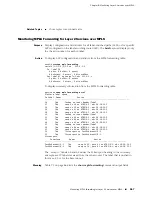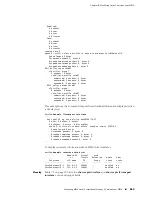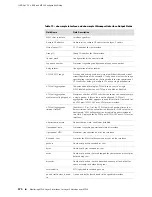
When a CE device connects to multiple PE routers, each of these routers advertises
reachability for the multihomed site—routes that have the same site ID in the layer2
NLRI. The other PE routers in the network use a BGP path selection process to select
only one of the advertising routers to which they send traffic destined for the CE
device. This path selection process eliminates layer 2 loops in the VPLS network.
BEST PRACTICE:
To prevent the creation of layer 2 loops due to a misconfiguration
or temporary loops during a topology change and subsequent convergence, we
recommend that you employ the Spanning Tree Protocol (STP) on your CE devices.
You specify on each PE router connected to the CE device in the VPLS that the site
is multihomed and you configure a priority. The priority serves as a site preference
and is propagated by BGP in the local-preference attribute.
You configure the same site ID (sometimes referred to as a VE ID) on these connected
PE routers. Each of these routers then advertises reachability for the multihomed
site; the VPLS NLRI contains the site ID. The site ID shared by the connected PE
routers should be different than the site IDs configured on the remote PE routers in
the VPLS network; if the site ID is not different, then the pseudowire will be in a site
collision state. The remote routers then use the site ID to identify where to forward
traffic destined for the customer site.
Although the site ID is the same for all connected PE routers, the block offset, label
range, and route distinguisher can be different for each PE router. The BGP path
selection process uses the block offset and label range only to determine whether a
layer 2 advertisement is relevant to the multihomed customer site. A route
distinguisher is helpful to uniquely identify a particular PE router when you are
troubleshooting a network.
The PE routers run the BGP path selection process on the locally originated and
received layer 2 route advertisements to establish that the routes are suitable for
advertisements to other peers, such as route reflectors. For this selection process,
the routes advertise different prefixes, distinguished by the site ID, block offset, and
route distinguisher.
The remote PE routers then run a modified selection process on these selected routes
for L2VPN multihoming. Because all the prefixes advertised by multihomed local PE
routers share the same site ID, the set of routes advertised for a multihomed site
effectively consists of multiple routes to a single prefix, distinguished by the site ID
alone. Therefore the result of the second selection process is the single best path to
the multihomed site.
The PE router that originates this advertisement then becomes the designated VE
device for the multihomed customer site. When the designated VE device is
determined for both the local and remote customer sites for the VPLS, then a VPLS
pseudowire is created between the designated VE devices.
The BGP best path selection process is run only in the core VPN address family. This
first selection process does not consider the down bit for VPLS (or the status vector
bit for VPWS).
BGP Multihoming for VPLS
■
581
Chapter 9: VPLS Overview
Summary of Contents for BGP
Page 6: ...vi ...
Page 8: ...viii JUNOSe 11 1 x BGP and MPLS Configuration Guide ...
Page 37: ...Part 1 Border Gateway Protocol Configuring BGP Routing on page 3 Border Gateway Protocol 1 ...
Page 38: ...2 Border Gateway Protocol JUNOSe 11 1 x BGP and MPLS Configuration Guide ...
Page 234: ...198 Monitoring BGP JUNOSe 11 1 x BGP and MPLS Configuration Guide ...
Page 236: ...200 Multiprotocol Layer Switching JUNOSe 11 1 x BGP and MPLS Configuration Guide ...
Page 542: ...506 Monitoring BGP MPLS VPNs JUNOSe 11 1 x BGP and MPLS Configuration Guide ...
Page 544: ...508 Layer 2 Services Over MPLS JUNOSe 11 1 x BGP and MPLS Configuration Guide ...
Page 610: ...574 Virtual Private LAN Service JUNOSe 11 1 x BGP and MPLS Configuration Guide ...
Page 624: ...588 VPLS References JUNOSe 11 1 x BGP and MPLS Configuration Guide ...
Page 680: ...644 Virtual Private Wire Service JUNOSe 11 1 x BGP and MPLS Configuration Guide ...
Page 724: ...688 Monitoring MPLS Forwarding Table for VPWS JUNOSe 11 1 x BGP and MPLS Configuration Guide ...
Page 725: ...Part 6 Index Index on page 691 Index 689 ...
Page 726: ...690 Index JUNOSe 11 1 x BGP and MPLS Configuration Guide ...
















































